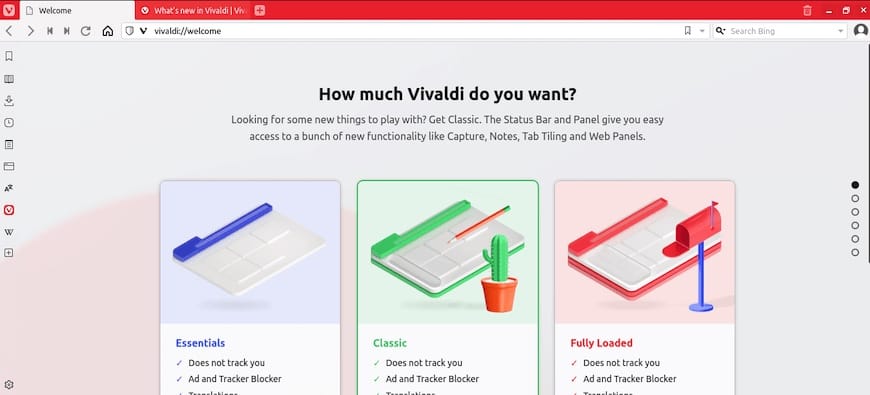How To Install Vivaldi Browser on Ubuntu 24.04 LTS

In the ever-evolving landscape of web browsers, Vivaldi stands out as a feature-rich and highly customizable option for users seeking a unique browsing experience. Based on the Chromium engine, Vivaldi combines powerful functionality with a user-centric approach, making it an attractive choice for Ubuntu users looking to enhance their web browsing capabilities.
Vivaldi Browser offers a plethora of innovative features that set it apart from its competitors. These include tab stacking for efficient organization, split-screen viewing for multitasking, customizable sidebar panels for quick access to frequently used tools, and a built-in ad blocker for a cleaner browsing experience. For Ubuntu 24.04 LTS “Noble Numbat” users, installing Vivaldi can significantly boost both performance and privacy while browsing the web.
Ubuntu 24.04 LTS, the latest long-term support release, provides a stable and secure foundation for running Vivaldi Browser. The compatibility between Vivaldi and Ubuntu’s latest offering ensures a smooth and seamless integration, allowing users to leverage the full potential of both the operating system and the browser.
In this comprehensive guide, we’ll walk you through the process of installing Vivaldi Browser on Ubuntu 24.04 LTS. From adding the necessary repositories to customizing your new browser, we’ll cover every step in detail, ensuring you can enjoy Vivaldi’s unique features with ease.
Prerequisites
Before diving into the installation process, it’s crucial to ensure that your system meets the necessary requirements and that you have the right tools at your disposal. This preparation will help guarantee a smooth installation experience.
System Requirements
To install and run Vivaldi Browser effectively on Ubuntu 24.04 LTS, your system should meet or exceed the following specifications:
- A 64-bit processor (x86_64)
- At least 2 GB of RAM (4 GB or more recommended for optimal performance)
- Minimum 1 GB of free disk space
- A stable internet connection for downloading the browser and its updates
While these are the minimum requirements, for the best experience with Vivaldi’s advanced features like tab stacking and split-screen viewing, a system with more robust specifications is recommended.
Necessary Tools
To successfully install Vivaldi Browser, you’ll need access to the following tools:
- Terminal access (press Ctrl + Alt + T to open the terminal)
- Sudo privileges on your Ubuntu system
- Basic familiarity with command-line operations
Ensure that your system is up to date before proceeding with the installation. You can do this by running the following commands in the terminal:
sudo apt update
sudo apt upgradeWith these prerequisites in place, you’re ready to begin the installation process for Vivaldi Browser on your Ubuntu 24.04 LTS system.
Step-by-Step Installation Guide
Follow these detailed steps to install Vivaldi Browser on your Ubuntu 24.04 LTS system. Each step is crucial for ensuring a proper and secure installation.
Step 1: Add the GPG Key
The first step in installing Vivaldi Browser is to add the GPG (GNU Privacy Guard) key. This key is essential for verifying the authenticity of the packages you’ll be downloading, ensuring they come from a trusted source.
To add the GPG key, follow these steps:
1. Open your terminal (Ctrl + Alt + T).
2. Install necessary packages by running:
sudo apt install wget gnupg2 ubuntu-keyring3. Download and add the Vivaldi GPG key:
wget -O- https://repo.vivaldi.com/archive/linux_signing_key.pub | sudo gpg --dearmor | sudo tee /usr/share/keyrings/vivaldi.gpgThis command downloads the public key, dearmors it (converts it from ASCII to binary format), and saves it in the appropriate location for APT to use during package verification.
Step 2: Add the Vivaldi Repository
Adding the Vivaldi repository to your system is crucial as it allows Ubuntu’s package manager to find and install Vivaldi Browser. This step ensures you can easily install and update Vivaldi using standard system tools.
To add the Vivaldi repository:
1. Run the following command in your terminal:
echo deb [arch=amd64 signed-by=/usr/share/keyrings/vivaldi.gpg] https://repo.vivaldi.com/archive/deb/ stable main | sudo tee /etc/apt/sources.list.d/vivaldi.listThis command creates a new list file for the Vivaldi repository, specifying that it should only be used for 64-bit (amd64) packages and that packages should be verified using the GPG key we added in the previous step.
Step 3: Update System Packages
After adding a new repository, it’s essential to update your system’s package lists. This ensures that your system recognizes the newly added Vivaldi repository and can access its packages.
Update your system’s package lists by running:
sudo apt updateYou may see output indicating that the Vivaldi repository has been added and its package lists have been fetched. If you encounter any errors during this step, double-check that you’ve correctly completed steps 1 and 2.
Step 4: Install Vivaldi Browser
With the repository added and package lists updated, you’re now ready to install Vivaldi Browser. Ubuntu’s package manager will automatically fetch the latest stable version of Vivaldi from the repository we added.
To install Vivaldi Browser, execute the following command:
sudo apt install vivaldi-stableThe system will prompt you to confirm the installation. Type ‘Y’ and press Enter to proceed. The package manager will then download and install Vivaldi Browser along with any necessary dependencies.
Step 5: Launch Vivaldi Browser
Once the installation is complete, you can launch Vivaldi Browser using either the terminal or the graphical user interface (GUI).
To launch Vivaldi from the terminal:
vivaldi &The ‘&’ at the end of the command runs Vivaldi in the background, allowing you to continue using the terminal.
Alternatively, you can launch Vivaldi from the GUI:
1. Click on the Ubuntu Activities button (usually in the top-left corner)
2. Type “Vivaldi” in the search bar
3. Click on the Vivaldi icon to launch the browser

Step 6: Initial Setup and Customization
When you first launch Vivaldi Browser, you’ll be greeted with a setup wizard that guides you through the initial configuration. This process allows you to tailor Vivaldi to your preferences right from the start.
During the initial setup, you can:
- Choose your preferred theme (light or dark)
- Set your default search engine
- Import bookmarks and settings from other browsers
- Configure privacy settings
- Customize the browser’s appearance and layout
Take your time to explore the various options available. Vivaldi’s strength lies in its customizability, so don’t hesitate to experiment with different settings to find what works best for you.
Some notable features to explore during setup or immediately after include:
- Tab Stacking: Group related tabs together by dragging one tab onto another.
- Web Panels: Add frequently visited websites to the sidebar for quick access.
- Quick Commands: Use Ctrl+Q to open a command interface for rapid navigation and browser control.
- Notes: Jot down ideas or save snippets of text directly in the browser’s sidebar.
Remember, you can always adjust these settings later by accessing Vivaldi’s comprehensive settings menu.
Updating Vivaldi Browser
Keeping your browser up-to-date is crucial for security, performance, and access to the latest features. Vivaldi Browser makes this process straightforward on Ubuntu 24.04 LTS.
Automatic Updates via Repository
One of the advantages of installing Vivaldi through the official repository is that it integrates with Ubuntu’s package management system. This means that Vivaldi will be updated alongside your other system packages when you perform routine system updates.
To check for and install all available updates, including those for Vivaldi, you can use the following commands:
sudo apt update
sudo apt upgradeThese commands will update your package lists and then upgrade all packages that have available updates, including Vivaldi Browser if an update is available.
Manual Update Commands
If you want to update Vivaldi Browser specifically, you can use the following commands:
sudo apt update
sudo apt install vivaldi-stableThis will update only the Vivaldi Browser package to its latest version available in the repository.
Checking Your Vivaldi Version
To verify your current Vivaldi version:
1. Open Vivaldi Browser
2. Click on the Vivaldi logo in the top-left corner
3. Select “Help” > “About Vivaldi”
This will display your current version and check for any available updates.
Uninstalling Vivaldi Browser
While we hope you’ll enjoy using Vivaldi Browser, there might be situations where you need to remove it from your system. Ubuntu’s package management system makes this process straightforward.
Steps to Remove Vivaldi
To completely remove Vivaldi Browser from your Ubuntu 24.04 LTS system, follow these steps:
1. Open your terminal (Ctrl + Alt + T).
2. Run the following command to remove the Vivaldi package:
sudo apt remove vivaldi-stable3. To remove any dependencies that were installed with Vivaldi and are no longer needed, run:
sudo apt autoremove4. Optionally, if you want to remove the Vivaldi repository from your system, delete the repository file:
sudo rm /etc/apt/sources.list.d/vivaldi.list5. Finally, remove the GPG key:
sudo rm /usr/share/keyrings/vivaldi.gpgAfter completing these steps, Vivaldi Browser will be completely removed from your system.
Troubleshooting Tips
While installing and using Vivaldi Browser on Ubuntu 24.04 LTS is generally a smooth process, you might encounter some issues. Here are some common problems and their solutions:
Installation Fails
If you encounter errors during installation, try the following:
1. Ensure your system is up to date:
sudo apt update && sudo apt upgrade2. Check your internet connection.
3. Verify that you’ve correctly added the Vivaldi repository and GPG key.
4. If issues persist, try removing and re-adding the repository and GPG key.
Browser Crashes or Performs Poorly
If Vivaldi crashes frequently or performs slowly:
1. Ensure you’re running the latest version.
2. Check if the issue persists in a new user profile (you can create one in Vivaldi’s settings).
3. Disable extensions one by one to identify if any are causing issues.
4. Clear browser cache and cookies.
Plugins or Extensions Not Working
If you’re having trouble with plugins or extensions:
- Ensure they’re compatible with the version of Vivaldi you’re running.
- Try disabling and re-enabling the problematic plugin or extension.
- Check if the issue persists in a private/incognito window.
Congratulations! You have successfully installed Vivaldi. Thanks for using this tutorial for installing the Vivaldi web browser on Ubuntu 24.04 LTS system. For additional help or useful information, we recommend you check the official Vivaldi website.